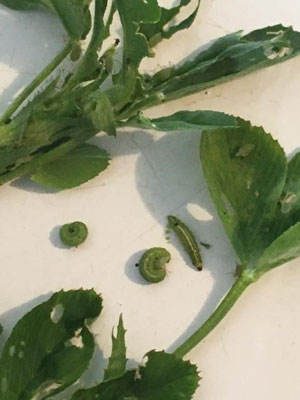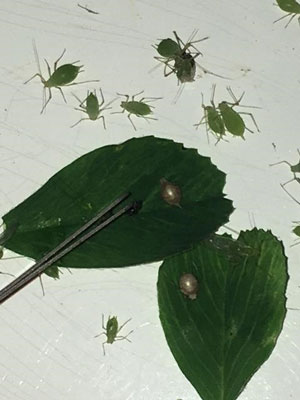Alfalfa Weevils
Alfalfa weevil larvae continue to feed and thus increase in size (Figure 1). However, after monitoring several fields throughout north central Kansas over the last 10 days, there was not yet any field that had a 50% infestation level. Infestation level is determined by the “stem count bucket” method where individual stems are removed and quickly shaken into a 1-gallon white bucket to dislodge any weevil larvae that may be present. Next, count the number of larvae in the bucket and divide into the number of stems shaken into the bucket to get the percent (%) of infested stems. Alfalfa weevil monitoring should continue, however, as we are still relatively early and more larvae will probably be hatching.

Figure 1 Alfalfa weevil larvae and leaf damage. Photo by Cody Wyckoff, K-State Research and Extension.
Pea Aphids
None of the fields sampled over the past 10 days had been treated with an insecticide. Thus, pea aphids are really prevalent and increasing in population density. However, much like alfalfa weevils, none of the fields monitored had infestation levels anywhere close to a treatment threshold. These pea aphid populations are often utilized by beneficials (see Figure 2 with pea aphids and parasitized pea aphids, called "mummies") early in the season to increase their populations, which often help against other pests in other crops, i.e. greenbugs, corn leaf aphids, soybean aphids, etc. Again, monitoring pea aphids should also continue until swathing.
Alfalfa weevils and pea aphids are considered cool-season pests and primarily affect alfalfa up to the 1st cutting. Most alfalfa weevil larvae detected (Figure 1) were late 1st/early 2nd instars, and thus will probably finish feeding in about 2 weeks at the temperatures predicted for that period of time (60-70's for daytime temperatures). Sampling for both alfalfa weevil larvae and pea aphids should continue until at least the 1st cutting.

Figure 2. Pea aphids and parasitized pea aphids. Photo by Cody Wyckoff, K-State Research and Extension.
Jeff Whitworth, Extension Entomologist
jwhitwor@ksu.edu
Tags: insects pea aphids alfalfa weevils